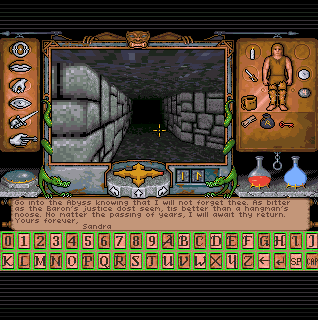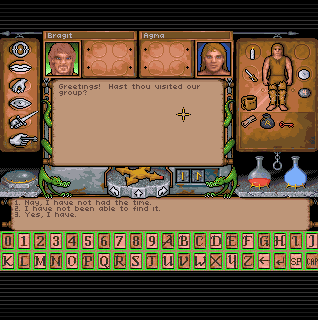|
|
Chris De Herrera's Windows CE Website |
|---|---|
About |
|
| By Chris De Herrera Copyright 1998-2007 All Rights Reserved A member of the Talksites Family of Websites Windows and
Windows CE are trademarks of
Microsoft All Trademarks are owned |
Ultima Underworld for
Pocket PC Review
By Allen Gall,
Copyright 2002
Revised 8/8/2002
[an error occurred while processing this directive]
Released a decade ago by Origin Systems, once one of the key developers of cutting edge PC games, Ultima Underworld started a new genre: the single-player, first person 3D RPG. Older games such as the “Gold Box Series” (Pool of Radiance, Curse of the Azure Bonds, The Bard’s Tale, etc.) had a first person 3D perspective, but in these “tile-based” games, movement was linear and consisted of short, choppy steps. While Castle Wolfenstein 3D showed what fluid, unrestricted movement could do for an arcade game, Ultima Underworld showed what it could do for an RPG. And instead of the usually flat topography of game levels, it added slopes, inclines, and platforms, a feature that wouldn’t become an industry standard until Doom II.
I won’t say too much about the original game, since most people have played it, and it’s been nearly a decade since I first fired up the game on my old 386-40. Instead, I will focus on how the game functions on today’s Pocket PC devices. Suffice it to say that, unlike many FPS games, it really was an RPG, focusing on interaction, exploration, character development, and it contained a detailed plot (I won’t reveal that, either). Gamers who wanted fast action and cartoon violence with no remorse were frustrated with the original Underworld, and they probably won’t like the Pocket PC version much better. However, those who played the game originally and those looking for a more thoughtful gaming experience may find this title enjoyable.
After you’ve installed the game and surrendered a rather hefty 14
megabytes of storage space for the installation process, you’ll create a
character in typical RPG fashion, selecting from several different types
and skill sets, then you’ll start the game in earnest.
As the “Underworld” title suggests, the game is primarily a
crawl through a spooky dungeon. The
actual 3D view takes up about a third of the screen.
Your character’s info is displayed to the right, complete with a
image displaying your character’s current weapons, armor, inventory, and
levels of health and mana (used to cast spells).
To the left of the 3D display are several buttons that make up the
game’s interface.
Since the original Underworld was based on mouse input, porting the controls over to the Pocket PC makes for a fairly smooth transition: simply tap and drag on the screen the direction you want to go, and your character will move. Speed can be adjusted proportionally depending on where you position the stylus relative to the X and Y axes. Interacting with the game environment consists of a somewhat clumsy method of clicking on icons to look, take, and use and then tapping on the appropriate item. You can equip weapons (you’ll go through plenty in a game like this) by simply dragging them over to the image of your character to the right. You’ll also find a virtual keyboard underneath the screen, but its letters use a sort of medieval fantasy design and color scheme that I found difficult to read.
A first person 3D game is all about immersion. On my desktop PC, for example, I’ve been somewhat obsessed with The Elder Scrolls III: Morrowind. My obsession with the game is based not just on the game’s story but the environment, with its rich textures and models, weather effects, realistic climates, and an attention to detail that allows me to easily pretend that I’m actually there. The overall experience of the game was enough to hook someone like me who’s developed an intense dislike of PC games in recent years. Such an experience is difficult to replicate on a handheld device with a fairly small screen.
Still, we can play stalwart classics such as Hexen and the original Quake, thanks to a couple of dedicated ports. While these mid-90s games play great, they look a bit crude. Ultima Underworld, unfortunately, looks downright ugly. For starters, you can really tell this game’s age when you realize how small the viewing window is. Gamers today expect titles to take up most, if not all, of the available screen space. This is especially important on Pocket PCs, were space is very limited. Back in 1992, of course, it probably wasn’t viable for Ultima Underworld to run in a larger view window without needing a top-of-the-line system. I remember being a little disappointed about the interface taking up most of the screen back when I played the original, and this issue is even more apparent when playing the game on a Pocket PC.
And what’s going on in that little view window doesn’t look so great, either. For starters, the frame rate is less than ideal. I remember this being an issue with the original, and I’m guessing it has something to do with the code rather than the Pocket PC itself. The graphics aren’t terrific. By the mid-90s, developers had come up with clever ways of providing fast frame rates while integrating graphics techniques to reduce the blockiness apparent whenever you move close to an object. In Underworld, the pixellization is often so severe that I sometimes felt like I was playing the game on a 160x160 Palm device. And if you’re the type of gamer who doesn’t like tromping through dungeons, you should probably avoid the game, especially if you have a 3800 series iPaq and are affected by the “dark screen” issue.
|
|
| Ultima Underworld has a great storyline and solid level design, although the interface and graphics are a bit underwhelming by today’s standards |
Of course, RPGs can get away with having less than stellar graphics since they’re more about game play and character development than eye candy. Underworld has plenty of the first two qualities, and that’s what will keep many gamers hooked regardless of whether they played the original. If you can get past the graphics and the interface, Underworld has a thoughtful storyline, one that thankfully doesn’t center on the tired motif of killing everything in sight. That’s the one aspect of the game that doesn’t seem dated. At heart, strong game play and compelling storylines were what made the entire Ultima franchise a worthwhile endeavor for many years.
|
|
| During its long, fruitful lifespan, the Ultima franchise was always about much more than mindless butchery, and Ultima Underworld was no exception—on the Pocket PC, it’s probably the closest thing we have thus far to a professional-quality RPG. |
This game highlights an issue I’ve had with some of ZioSoft’s recent titles—it’s time for them to focus on original content rather than recycling older PC games. Don’t get me wrong--they did a great job with SimCity 2000, and as a fan of the Need For Speed franchise, I’m eagerly looking forward to being able to carry that game around in my pocket. Still, I’d rather see them focus their efforts more on original titles developed specifically for the Pocket PC. I love the concept behind Underworld—I think if they’d rebuilt the game from the ground up to take advantage of current Pocket PC hardware or even developed a “copycat” title, the end result would’ve looked and played a lot better than this title does. Now that 400mhz devices are starting to become part of the Pocket PC’s user base, there’s really no reason not to take advantage of that power.
Ultima Underworld was a great RPG back in its heyday, and since there aren’t many good RPGs currently available for the Pocket PC (we’re all wondering how Sorcery is going to pan out), it’s probably one of the best RPGs you can get for your handheld. Veteran gamers who played the original will probably enjoy the sense of deja-vu they get from playing it on their PDAs, but “hack and slash” action gamers and those who missed out the first time around will likely be put off by the game’s limitations, most of which are attributable to its age.
Ultima Underworld is available for all Pocket PCs at a very reasonable price of $29.95 from ZioSoft.
Allen Gall is a freelance game reviewer and the games editor for CEWindows.NET. If you have a game you'd like Allen to review, you can e-mail him at allen@cewindows.net
[an error occurred while processing this directive]




